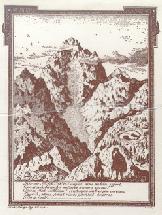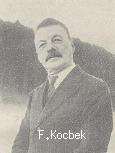 The first visitors of our mountains were the local guys: hunters, shepherds,
ore-seekers, herb-collectors, but they were not explorers. But already in
the 18th century, more learned men visited our mountain world.
One of the very first was Baltazar Hacquet, a great mountain hiker
and an enthusiastic explorer of our mountains and all the eastern Alps
(left is his map of Triglav and Velo polje from his book
Oryctographia Carniolica, dated 1776).
Already in 1777, he climbed Mali Triglav, whereas in 1778, the wound-healer
Lovrenc Willomitzer and the locals Luka Korosec,
Stefan Rozic and Matija Kos climbed to the top of Triglav
(2864m), our highest peak. Other explorers, mostly nature scientists
(mostly botanists), were also among the first that trodded the paths
of our mountains. Let us only mention A. Scopoli who climbed
Storzic (2132m) in 1758 and Grintovec (2558m) in 1759, as well as
F. X. Wulfen and F. Hohenwart who climbed Planjava (2392m)
in 1793 and Mangart (2678m) in 1794.
The first visitors of our mountains were the local guys: hunters, shepherds,
ore-seekers, herb-collectors, but they were not explorers. But already in
the 18th century, more learned men visited our mountain world.
One of the very first was Baltazar Hacquet, a great mountain hiker
and an enthusiastic explorer of our mountains and all the eastern Alps
(left is his map of Triglav and Velo polje from his book
Oryctographia Carniolica, dated 1776).
Already in 1777, he climbed Mali Triglav, whereas in 1778, the wound-healer
Lovrenc Willomitzer and the locals Luka Korosec,
Stefan Rozic and Matija Kos climbed to the top of Triglav
(2864m), our highest peak. Other explorers, mostly nature scientists
(mostly botanists), were also among the first that trodded the paths
of our mountains. Let us only mention A. Scopoli who climbed
Storzic (2132m) in 1758 and Grintovec (2558m) in 1759, as well as
F. X. Wulfen and F. Hohenwart who climbed Planjava (2392m)
in 1793 and Mangart (2678m) in 1794.
The first Slovenian alpinist was Valentin Stanic (1774-1847) who counted numerous first ascents to Austrian mountains. In 1800, he performed measurements on Grossglockner (3797m), in 1801 he was on Hocheck, in 1808 as the fourth person to climb Triglav, and so on. He was among the first mountain climbers that `walked' around without a guide.
 At the end of the 19th century, the joint German-Austrian Mountaineering
Society (DÖAV, Deutsch-Österreichischer Alpenverein,
merged in 1874) had five sections (outlets): in Kranj, Maribor,
Celje, Villach and Trieste. Foreign mountain climbers marked
German paths and built German mountain huts on our
territory, which the Slovenian hikers were not allowed to use.
They were very few Slovenian hikers at that time: Franc Kladnik
(1925-1908) was one of them, a never-tired solo walker. But the
first initiative to establish a Slovenian mountaineering organisation
came already in 1872 from Ivan Zan from Srednja vas in Bohinj.
The society of `The Friends of Triglav' had one primary goal: to take
care of the `Triglav Temple', i.e. a bivouac on Prodi, the first
little mountain hut in the immediate vicinity of Triglav. But the
foreign authorities prevented this Society to be formed. Two great
fans of our mountains were
dr. Johannes Frischauf
(1838-1924) who was very active in the Kamniske Alps,
and dr. Julius Kugy (1858-1944),
who preferred the Julian Alps.
Dr. Henrik Tuma (1858-1935)
was also a big enthusiast and an alpinist. In addition, the local
guides
had an immensely important role in this period, since they knew many
ascents and were aware of many hidden dangers.
At the end of the 19th century, the joint German-Austrian Mountaineering
Society (DÖAV, Deutsch-Österreichischer Alpenverein,
merged in 1874) had five sections (outlets): in Kranj, Maribor,
Celje, Villach and Trieste. Foreign mountain climbers marked
German paths and built German mountain huts on our
territory, which the Slovenian hikers were not allowed to use.
They were very few Slovenian hikers at that time: Franc Kladnik
(1925-1908) was one of them, a never-tired solo walker. But the
first initiative to establish a Slovenian mountaineering organisation
came already in 1872 from Ivan Zan from Srednja vas in Bohinj.
The society of `The Friends of Triglav' had one primary goal: to take
care of the `Triglav Temple', i.e. a bivouac on Prodi, the first
little mountain hut in the immediate vicinity of Triglav. But the
foreign authorities prevented this Society to be formed. Two great
fans of our mountains were
dr. Johannes Frischauf
(1838-1924) who was very active in the Kamniske Alps,
and dr. Julius Kugy (1858-1944),
who preferred the Julian Alps.
Dr. Henrik Tuma (1858-1935)
was also a big enthusiast and an alpinist. In addition, the local
guides
had an immensely important role in this period, since they knew many
ascents and were aware of many hidden dangers.
 A decisive initiative to form a Slovenian mountaineering society
was given in 1892 by the `piparji', an enthusiastic bunch of young
climbers, led by the `super-pipar' Jozef Hauptman. On February
27th 1893, the Slovenian mountaineering society (Slovensko planinsko
drustvo, SPD) was founded in Ljubljana, and dr. Fran Orozen
was elected as its first president. Soon other outlets all over Slovenia
were brought to life, in 1893 in Ljubljana, Kamnik and Savinjska region,
in 1895 in Radovljica, in 1896 in Soca, etc. By 1914, there were
26 outlets with 3337 members. Everywhere in our mountains, mountain huts
were set up (on Crna prst and Molicka planina in 1894, in Vrata and Velo polje
in 1895, on Kredarica in 1896, etc.) and paths were being marked.
The important people of that time were Jakob Aljaz, a priest from
Dovje near Mojstrana, who put up the famous little tower at the top
of Triglav in 1895,
Fran Kocbek,
who was the head of the Savinjska
outlet of SPD for 30 years and wrote a magnificent book about the
Kamniske Alps, Fran Orozen, and many others. The `drenovci'
Bogumil Brinsek, Rudolf Badjura, Pavel Kunaver,
dr. Josip Cerk, Ivan Michler, Ivan Tavcar
were the first to initiate and support winter mountaineering, cave exploration,
alpinism, skiing and mountain photography. For example, Badjura wrote
28 guidebooks! The central personality of SPD until 1931 though was
dr. Fran Tominsek, the vicepresident of SPD in the first years of
its existence and president from 1908 to 1931. In 1912, the Mountaineering
rescue service was founded in Kranjska gora by dr. Jernej Demsar
and dr. Josip Ticar.
A decisive initiative to form a Slovenian mountaineering society
was given in 1892 by the `piparji', an enthusiastic bunch of young
climbers, led by the `super-pipar' Jozef Hauptman. On February
27th 1893, the Slovenian mountaineering society (Slovensko planinsko
drustvo, SPD) was founded in Ljubljana, and dr. Fran Orozen
was elected as its first president. Soon other outlets all over Slovenia
were brought to life, in 1893 in Ljubljana, Kamnik and Savinjska region,
in 1895 in Radovljica, in 1896 in Soca, etc. By 1914, there were
26 outlets with 3337 members. Everywhere in our mountains, mountain huts
were set up (on Crna prst and Molicka planina in 1894, in Vrata and Velo polje
in 1895, on Kredarica in 1896, etc.) and paths were being marked.
The important people of that time were Jakob Aljaz, a priest from
Dovje near Mojstrana, who put up the famous little tower at the top
of Triglav in 1895,
Fran Kocbek,
who was the head of the Savinjska
outlet of SPD for 30 years and wrote a magnificent book about the
Kamniske Alps, Fran Orozen, and many others. The `drenovci'
Bogumil Brinsek, Rudolf Badjura, Pavel Kunaver,
dr. Josip Cerk, Ivan Michler, Ivan Tavcar
were the first to initiate and support winter mountaineering, cave exploration,
alpinism, skiing and mountain photography. For example, Badjura wrote
28 guidebooks! The central personality of SPD until 1931 though was
dr. Fran Tominsek, the vicepresident of SPD in the first years of
its existence and president from 1908 to 1931. In 1912, the Mountaineering
rescue service was founded in Kranjska gora by dr. Jernej Demsar
and dr. Josip Ticar.
A strong blast for the SPD was the first world war ravaging also through our mountain world. After WWI, we lost a great deal of the national territory (Carinthia, the river Soca region, the coastal region of Primorska, Notranjska), in which 13 outlets were in operation. For instance, the border to Italy was (also) at the top of Triglav and along one of its ridges. The Slovenian people in Italy and Austria were subjected to strong opression and assimilation. The weakened SPD recovered to some extent in the old, post-WWI, pre-WWII Yugoslavia, but in general, all strength had to be invested into economical prosperity and stability. Young climbers therefore again took the initiative and in 1921, they founded the `tourist' (==mountaineering) club `Skala' (==the rock). Professor Janko Ravnik was its head, dr. Henrik Tuma was its ideological leader, and dr. Klement Jug its prime climber. In the years between WWI and WWII, slovenian alpinism slowly evolved and counted many successes in our mountains. The most prominent climbers were Pavla Jesih, Mira Debelak, Joza Cop, dr. Stanko Tominsek, dr. Miha Potocnik, Uros Zupancic and also Vinko Modec, Boris Rezek and Vlasto Kopac in the Savinjske Alps. The club `Skala' was really the most important promoter of alpinism; in 1934 the alpinist section of the SPD was founded.
Since 1931, dr. Josip Pretnar was the head of the SPD. In 1933, the youth section of the SPD was formed (it took care of smaller outlets that were being founded in schools). In 1939, the SPD had 8116 regular members, 1071 members of the academic section (students) and 1947 members of the youth section. The SPD had a big reputation in the old SHS (the kingdom of the Serbs, Croats and Slovenians, i.e. the pre-WWII Yugoslavia); in fact, the head office for all mountaineering societies in SHS was in Ljubljana after 1931. At that time, the SPD had also established relations to the international UIAA.
During WWII, the activities of the SPD were virtually at a standstill. The Germans who occupied the northern and southeastern part of Slovenia, dismissed all outlets of the SPD, and many nationall conscious Slovenians were either arrested, expatriated or sent into concentration camps. The Italians, who occupied the western and the southwestern part did not directly forbid the SPD, but they surrounded the capital city Ljubljana with the famous barbed-wire fence and watchposts with a 36km circumference. Many members of the SPD joined the partisans or the Liberation Front in their fight against the foreign invaders, and the head office of the SPD was transformed into the ammunition storage spot. Many prominent climbers like Miha Arih, Mian Cizelj, Matevz Frelih, Franc Herle, Fran Ogrin, and other members of the SPD died during WWII, and of 69 mountain huts, 49 were destroyed and 20 looted.
But already in the first months after the liberation, the outlets of the SPD were brought back to life. On February 24th 1946, the Mountaineering society of Slovenia was founded (PDS) with 17 outlets. Dr. France Avcin was the first, and Vlasto Kopac its second president. In 1948, the PDS was renamed into PZS, Planinska zveza Slovenije. After that, the local societies and outlets became more and more numerous. Membership was augmented, mountain huts were being rebuilt, new paths were made and old were reconstructed and marked, guided group tours were organised and lessons were taught to the new members. In 1951, there were 57741 members of PZS, 77 mountain huts and 6 bivouacs. Today (as of 1998), there are 165 mountain huts and bivouacs, and about 150.000 official members (at a total population of 2.000.000!) of the PZS and many more that visit our mountains just like that; we can say that mountaineering is our truly `national sport'.